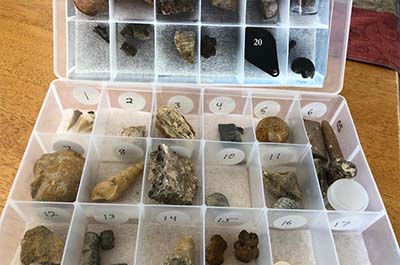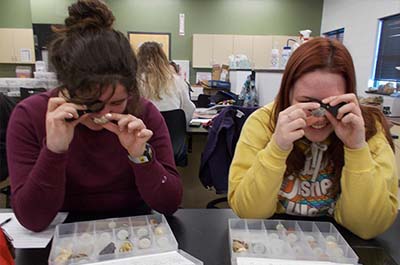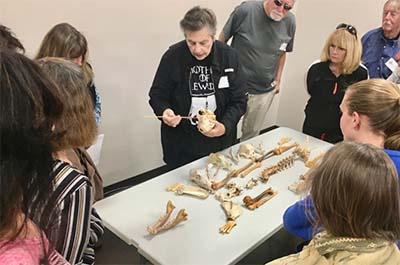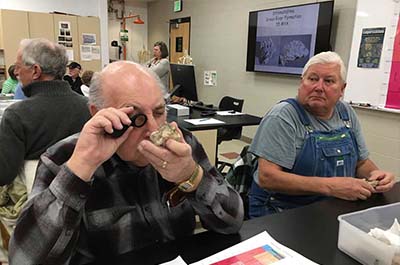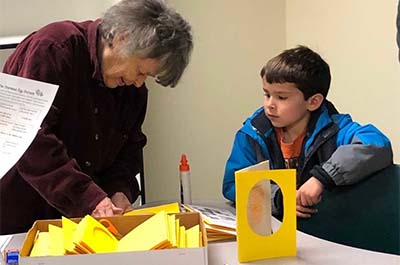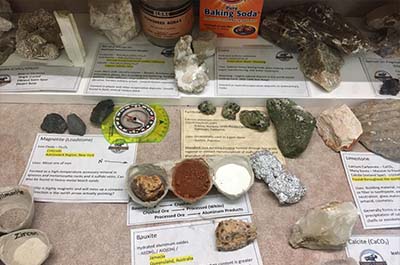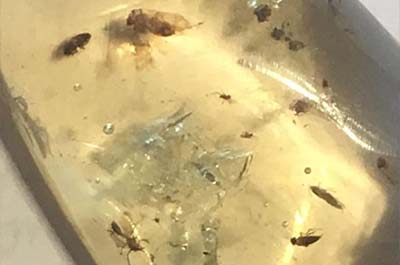Fremont County Quarry Exhibit
Two of Fremont County’s historic quarries are featured in a new display at the Fremont County Administration Building in Cañon City. Loretta Bailey and her daughter Kimberly developed a delightful exhibit focusing on the Mica Lode Quarry at the Royal Gorge and the Cowan Brothers Quarry on 8 Mile Hill, both well known quarries operating in the 1940’s and 1950’s.
Display at the Fremont County Administration Building on the quarrying industry in the 1950’s. Note the surrounding conglomerate.
The building stone used for both the interior and exterior of the County Admin Building is a unique conglomerate quarried by the Cowan Brothers out of 290 million year old rock deposited as the Fountain Formation and subsequently eroded and exposed just west of Cañon City. A conglomerate is made up of rocks of varying sizes (from pebbles up to boulders) jumbled together in a matrix. Rarely do conglomerates make good building stone, as they crumble easily. However, this conglomerate was modified perhaps a million years ago by an underground spring near the quarry that coated the area with a limestone carbonate which cemented the formation into a solid rock capable of being used as a building stone.
Shorty Stevens teaching his great grandchild Emily Myer and his granddaughter Kimberly Worsham about his former quarrying days in 1999.
Visitors can view the photos in the display case of the conglomerate being quarried, and then see the finished product on the polished walls holding up that display case. Fossil crinoids found in the conglomerate have been showcased in frames throughout the County Admin Building. Visitors are welcome go on a lucrative and comfortable fossil hunt without dealing with the usual field trip realities of sticky mud, sticky cactus and nasty snakes.
Conglomerate being quarried at the Cowan Brothers Quarry. The finished product can be viewed on the walls next to the exhibit.
Loretta researched the Ball Mill process used at the Mica Lode Quarry to separate the feldspar, quartz, and mica. Inside one History Center folder, she discovered a photo of the ball mill, one of the few operating in the country at that time. The exhibit explains the details involved in the ball mill operation.
Historic quarrying operations complete with ore samples
Loretta’s father (and Kimberly’s grandfather), Loyd Stevens, spent his life working in Fremont County hard rock quarries. Shorty, as he was known, would bring pretty rocks home to his children in his lunch box, and many of these minerals are in the display, including a quartz terminated at both ends (with a bit of titanium adding a rose color), tourmaline, garnets, and beryl.
Details of the Mica Lode Quarry
Shorty involved his family in his work, teaching them about quarrying, taking them to safe working sites when they were young children, and thus providing them with a lifetime of memories, a fascination with rocks, and an innate understanding of quarrying. At four years old, Loretta and her brother got to ride in the truck with a load of freshly-blasted dolomite from the CF&I Quarry into town where the load was dumped into box cars for shipping. The sounds of the boulders sliding out of the truck and slamming into the box cars remains crystal clear to Loretta to this day.
For more Fremont County history, visit Loretta’s blog “Now and Then” on the Royal Gorge Regional Museum and History Center’s website: https://royalgorgehistorycenter.wordpress.com/
More Articles from “Stones ‘n’ Bones Activities”
Fossil Boot Camp – Covid Style
Stones ‘n Bones of Fremont County traditionally presents two or three Fossil Boot Camp classes each year for school age students and adults. With COVID, that has proven a little difficult
Fossil Boot Camp for PCC Historical Geology Students
Fremont Stones ‘n Bones introduced 16 Pueblo Community College students to fossils in Steve Wolfe’s Historical Geology class.
Stones ‘n’ Bones With Villa Bella School’s 2nd Graders
“What do paleontologists do?” is the question we were asked to help answer for 50 second graders at Pueblo, Colorado’s newest elementary school on January 16, 2020.
The Close Relationship Between Man & Dog
Dr. Sue Ware returned to the Royal Gorge Dinosaur Experience for the second time, to the delight of 27 community members. She presented a program entitled “From your Campfire to your Bed: The Evolution, Importance & Relationship between Dogs and Humans”.
Fossil Boot Camp at PCC Mini-College
For the 5th straight year, Stones ‘n Bones presented Fossil Boot Camp to 31 senior citizens in the Fremont County community.
Stones ‘n’ Bones & the Enormous Egg
What happens when an entire elementary school reads the same book, The Enormous Egg, and asks Fremont County Stones and Bones to come in to help with the family night to celebrate the reading? A two-hour evening full of paleontology learning!
Introducing Geology Students to Fossils
How does Steve Wolfe, Historical Geology instructor at PCC-Fremont Campus, prepare his students for field season observations? One way is by introducing them to fossils
Identifying Trilobites
The Pioche Formation of eastern Nevada is world famous for its amazing preservation of trilobites. Very old trilobites, from the Lower Cambrian (542 – 521 million years old), almost the oldest on record.
Everything Begins With Mining
There are many ways to appreciate rocks. Many of us notice them simply for their color, texture and shape, irresistible and raw in nature.
Insects Trapped in Amber
Many of us are familiar with the high preservation of insects and leaves in the Green River Formation, a Colorado lagerstätte well known for field trips yielding magnificent fossils.

